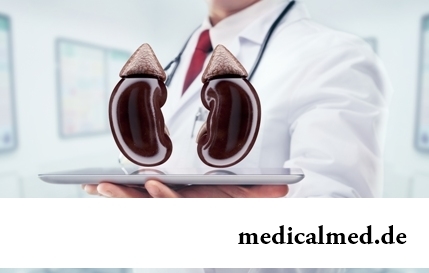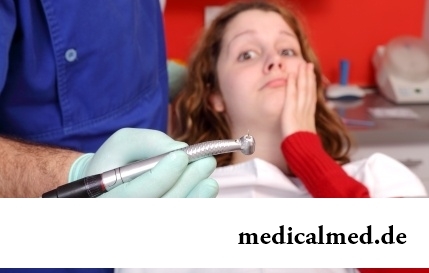





Ring-shaped granuloma
 The chronic disease of skin which is characterized by emergence of the towering dense small knots creating a ring with slightly sinking down or normal skin in the center is called a ring-shaped granuloma.
The chronic disease of skin which is characterized by emergence of the towering dense small knots creating a ring with slightly sinking down or normal skin in the center is called a ring-shaped granuloma.
The disease in most cases proceeds asymptomatically and does not demand special treatment, however for acceleration of healing of small knots the doctor can appoint corticosteroid cream or hypodermic introduction of corticosteroids. According to statistical data, the ring-shaped granuloma occurs at 0,4% of patients with dermatological diseases.
The origin of a granuloma remains to the unknown, however pathologies of immune system against the background of which allergic reactions of the slowed-down type develop are assumed and cellular immunity is broken. The factors contributing to a ring-shaped granuloma are:
- Sarcoidosis and tuberculosis;
- Conducting tuberkulinovy tests;
- Genetic predisposition;
- Autoimmune thyroiditis;
- Rheumatism and vasculitis;
- Long reception of vitamin D;
- Skin injuries, sunblisters and stings of insects;
- Diabetes mellitus.
Allocate the following forms of a ring-shaped granuloma:
- Disseminated;
- Hypodermic;
- Perforating;
- Localized.
In medical practice cases when the ring-shaped granuloma developed on site hems and tattoos, after shingles and warts often meet.
Symptoms of a ring-shaped granuloma
The main symptom of a ring-shaped granuloma is emergence on the skin of the patient of small knots of yellowish color, or a shade surrounding the struck place of skin. These small knots can form one or several rings, often appear on feet, brushes, hands and legs of adults and children. The ring-shaped granuloma usually does not cause an itch or pain in the place of emergence.
Ring-shaped granuloma at children
The form of a granuloma which is the most extended among children is localized, it meets in 90% of cases. On extensor surfaces of brushes, hands, feet and shins, is more rare in periorbital area, one or several centers with dense thermal papules appear. Color of educations usually matches tone of surrounding skin, or a little reddish, papules in the form of an arch or a ring of 2-5 cm and more are located, the central site of the center and epidermis usually remain not struck.
The local ring-shaped granuloma at children on the periphery extends, partially recuring or being resolved on the same place. In medical practice cases when children had rings enclosed one in another, reminding a mnogoformny exudative erythema are registered.
The hypodermic form of a ring-shaped granuloma occurs only at children under 6 years, it has an appearance single or the multiple deep, clinically not expressed, hypodermic or thermal small knots on elbows, a periorbital zone, forearms, shins, fingers, the back of brushes and on a pilar part of the head. Feature of this type of a granuloma is that the nodes which are formed on a pilar part of the head in all cases are densely connected to a periosteum while nodes on extremities mobile, and are only in rare instances connected with fastion.
The disseminated ring-shaped granuloma occurs at children extremely seldom, generally from it adults at the age of 50 years suffer and are more senior. Displays of a disease are widespread on all body, and also trunks, papules of a violet shade or skin color are more often on distal sites of extremities. Tendency to a koltsevidnost at such skin educations is absent, polylithism of rashes is noted.
The perforating ring-shaped granuloma occurs generally at children and adults aged up to 30 years. On brushes or fingers of patients there are papules with traffic jams on the center which allocate zhelatinopodobny contents then the centers and crusts with umbilicate impression in the center are formed. These educations develop in large plaques, with atrophic hyper over time - or the hypopigmented hems.
Diagnosis of a ring-shaped granuloma
At emergence of small knots the patient needs to ask for the help the dermatologist or the dermatovenerologist who on a clinical picture will be able to make the exact diagnosis. Only in the most doubtful cases at the patient skin in the place struck with a granuloma can take sample.
Treatment of a ring-shaped granuloma
Usually the disease does not demand special treatment and passes by itself. For more bystry healing of skin the doctor can appoint cream which part corticosteroids, or intradermal administration of corticosteroid drugs are. Important after use of ointment from above to apply an occlusive bandage skin.
Means need to be applied daily for two weeks, then for 2-3 weeks to put time in two days.
Also treatment of a ring-shaped granuloma can be performed by means of superficial scarification, sometimes the biopsy leads to permission of the center.
 The phototherapy, Puva-terapiya, Ural federal district, use of retinoids and anti-malarial drugs are included in the list of possible system influences at a granuloma, however any of them is not reliably effective and is not recommended for treatment of children.
The phototherapy, Puva-terapiya, Ural federal district, use of retinoids and anti-malarial drugs are included in the list of possible system influences at a granuloma, however any of them is not reliably effective and is not recommended for treatment of children.
It is clinically confirmed that the cryolysis which is used for treatment of a ring-shaped granuloma in cosmetology leads to progressing of a disease and growth of the centers on the periphery.
For treatment of the localized form of a ring-shaped granuloma at children safe means is corticosteroid ointment of the fourth generation Psoriderm which efficiency is confirmed by clinical trials. Thanks to the fact that means is used in a small dose and is applied on the local site of skin, probability of emergence of side effects very low cases with those were not registered.
The ring-shaped granuloma represents high-quality skin nodulation, creating a ring which do not cause pain or an itch. Usually educations take place by itself after a while, however if at the patient manifestations, atypical for a granuloma, are observed, it is necessary to address the dermatologist.
Statistically, on Mondays the risk of getting injured of a back increases by 25%, and risk of heart attack – for 33%. Be careful.

Beauty shop – the place which is associated only with positive emotions: joy, pleasure, relaxation. One...
Section: Articles about health
The name of this disease precisely reflects the problem reason: it consists in the bra fastener pressure upon a certain zone of a back. At the same time one of vertebrae of chest department of a backbone is as if blocked and loses mobility, and falling on it is nude...
Section: Articles about health
Small appetite at the child – the complaint which pediatricians should hear practically from each mother. Most often it is carried to the category of children's whims, however the refusal of food in certain cases can be to alarming symptoms therefore it cannot be ignored....
Section: Articles about health
Radiological methods of a research are applied in medicine more than hundred years, and thanks to them millions of lives were saved. In m...
Section: Articles about health
Nightmares belong to the most unpleasant frustration. Statistically, they happen at 4% of adults, and almost at 70% of children and teenagers. During a nightmare of people dreams himself in extremely difficult, life-threatening situation. It wakens suddenly, in...
Section: Articles about health
Musicotherapy – a treatment method which caused and causes a set of a controversy concerning its efficiency. However the facts are relentless: during the numerous researches curative impact of music on an organism was scientifically confirmed. Since then in a number of the countries the technique is included complex therapy of diseases of cardiovascular and respiratory system, dorsodynias and a backbone, psychosomatic disturbances and many other illnesses. The musicotherapy in a pedi is especially widely applied...
Section: Articles about health
It is pleasant to state a possibility of improvement of quality of life of people with problems of functioning of secretory system. By efforts that...
Section: Articles about health
The next flu epidemic leads to the next panic, from year to year we give in on these manipulations: professionally alarming voice of the announcer in news, reports with calculation of the died patients, an interview with people in white dressing gowns and advertizing of anti-influenza means ра...
Section: Articles about health
Helminthosis is one of the most widespread diseases. Statistically, any species of helminths infected every third inhabitant of the planet. Most of specialists even consider these data strongly underestimated: some uninvited "cohabitants" do not cause the carriers serious troubles, and patients just do not see doctors. The situation is aggravated also with the fact that people know about specifics of similar illnesses very little. At many presence of worms is strong ассоциир...
Section: Articles about health
Hemorrhoids – extremely widespread disease. Periodically arising inflammations and bleeding of hemorrhoidal nodes пр...
Section: Articles about health
Life does not indulge the modern woman special emotional comfort and carelessness. The fatigue, troubles at work, misunderstanding in a family and various illnesses immediately affect a condition of hair and skin. And to look safe and attractive so хоч...
Section: Articles about health
Stroke (acute disorder of cerebral circulation) – one of the most widespread neurologic diseases. Annually in the world more than 6 million people die of this illness. From the survived patients about 80% become disabled people, and nearly a third from them needs afterwards permanent care. In fact, the stroke creates a situation at which a part of cells of a brain loses blood access, loses an opportunity to receive oxygen and nutrients, and perishes. As a result of a razviv...
Section: Articles about health
The popular expression "run from a heart attack" became the motto of the people supporting active lifestyle. Moreover, run became peculiar...
Section: Articles about health
Each woman has preferences in the field of use of those goods which help us to look good, feel young and effective. Besides: selection process of favourite perfume, shampoo or decorative cosmetics already lifts a spirit...
Section: Articles about health
Very often as a source of the infection which caused a disease serves our house - the place which a priori has to be safe. However disease-producing bacteria can perfectly feel not only in insanitary conditions, but also in our apartment if not to carry out due care of favourite places of their dwelling. What they − sources of their reproduction? Let's consider 10 most widespread places in our house, the most dangerous from the point of view of infection with microorganisms....
Section: Articles about health
Epilepsy is one of widespread neurologic diseases. To parents, whose children suffer from this illness, it is necessary...
Section: Articles about health
Partial and the more so full loss of hearing significantly reduces quality of life. Difficulties with communication lead to loneliness and isolation. The person who badly hears experiences difficulties with social and professional implementation, quite often has problems in...
Section: Articles about health
Frosty air, fresh wind and easy snowball at most of Russians are associated with cheerfulness, health and cheerful entertainments on which our winter is so generous. But, unfortunately, cold season sometimes brings also troubles with health. It is not about seasonal colds and frostbites, and about those chronic illnesses which symptoms are shown preferential in the winter....
Section: Articles about health
No, probably, the person who would not have cold. Cold, cough, a headache – these symptoms are known to everyone. Peak to Prost...
Section: Articles about health
All are familiar with cold, and practically everyone believes that he has sufficient knowledge and experience that correctly to treat it. In practice most of people makes mistakes in attempts to get rid of rhinitis, and divides numerous delusions it....
Section: Articles about health
Ability of an organism to resist to adverse environmental factors (to impact of temperature drops, humidity and pressure, to the attacks of causative organisms, etc.) directly depends on what the person eats. Business here not only in that cells of a body received a necessary set of nutrients, vitamins and microelements. Scientists established that such components which are capable to influence negatively immune system, in connection with also are a part of foodstuff...
Section: Articles about health
The saying "the rich do not know how the other half lives" is known to all. In a broad sense it is that we can not always understand the person, about...
Section: Articles about health
The mankind knows that some toxins at intake in the minimum quantities have therapeutic effect from an extreme antiquity. Many substances recognized poisonous are applied in the medical purposes also today, being the main deystvuyushch...
Section: Articles about health
Kidneys perform the most important function of clarification of blood from those products of metabolic processes which cannot be used by an organism for obtaining energy and construction of new cells. With the urine produced by kidneys from a body of the person the bulk of the toxins getting to it with food and water is removed. Normal functioning of kidneys provides removal from an organism of excess liquid and maintenance of optimum ionic balance. At emergence of failures in work of secretory system...
Section: Articles about health
The fatigue, sleep debt, disturbances of food, bad mood, vagaries of the weather – all these circumstances badly are reflected in our vn...
Section: Articles about health
Statistically, can only one of ten of our compatriots brag of a decent condition of an oral cavity. Six teeth affected with caries are the share of the average Russian. For comparison, this indicator for Europeans almost six times exchanges...
Section: Articles about health
The stroke is one of the most widespread diseases of the person, annually in the world about 6 million cases of this pathology are registered. According to medical statistics, strokes occur almost three times more often than myocardial infarctions. The disease belongs to heavy, and has an unfavourable result: the lethality reaches 40% among women and 25% among men. A considerable part of the patients who endured a stroke cannot be recovered completely. We suggest readers to examine...
Section: Articles about health
